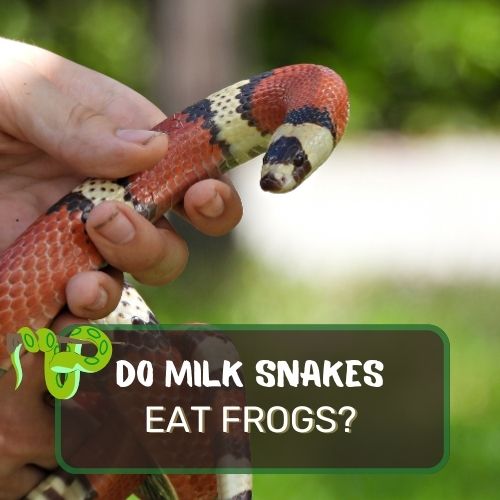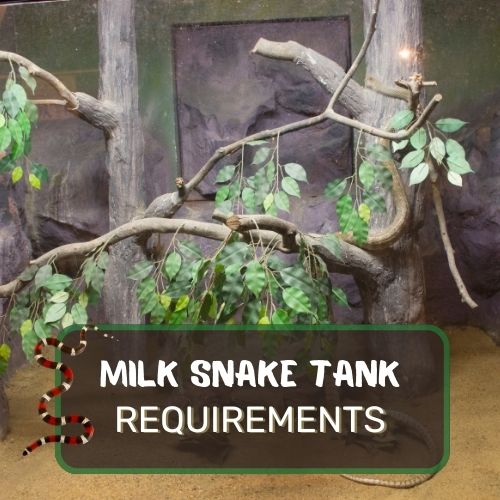Dive deep into the intriguing world of milk snakes and their fascinating dietary choices! Ever wondered why mice seem to be the top item on their menu? Or how their hunting prowess translates from the wild terrains to the comforts of captivity?
Yes, milk snakes do eat mice. In the wild, they’re opportunistic hunters, consuming mice, birds, and other small creatures. In captivity, mice become a primary part of their diet due to their nutritional balance, making them an ideal food source for the snake’s overall health and growth.
In this article, we’re unraveling the mystery of what milk snakes eat, the techniques they employ to snag their prey, and the dietary nuances between their wild and domesticated lives.
From nutritional benefits to potential feeding risks, we’ve covered all the angles. Get ready for a slithery culinary journey!

Table of Contents
Milk Snakes in the Wild: Their Natural Diet
Let’s dive right into the mysteries of the milk snake diet.
Foods That Milk Snakes Relish in the Wild
These snakes are nothing if not versatile diners, always ready to switch up their menu based on what’s available in the buffet of nature.
- Rodents: Mice, of course, are the star of the show. But they also wouldn’t say no to a juicy rat or vole.
- Birds: Especially the ones that are ground-dwellers.
- Bird Eggs: A delicacy! Think of them as the snake’s version of a poached egg breakfast.
- Reptiles: Including lizards and even smaller snakes. Yes, sometimes it’s a snake-eat-snake world out there!
- Amphibians: Frogs and salamanders are on the menu, particularly in wetter environments.
- Insects: Though not their primary food, they occasionally snack on large insects when other prey is scarce.
It’s quite the smorgasbord, isn’t it? Nature ensures milk snakes have plenty of options to satisfy their hunger, keeping them agile and ever-ready for the hunt. Every meal is an adventure!
How Their Environment Shapes Their Diet
The environment is like the grand maestro orchestrating the dietary habits of milk snakes. In regions abundant in rodents, milk snakes enjoy a mouse buffet.
But in places where rodents are scarce, they might switch things up and opt for more birds or even amphibians. It’s all about what’s available and easy to catch.
Terrain plays a role too. In forested areas, for instance, they might stumble upon more bird nests, leading to a delightful egg breakfast.
How Often They Eat
Now, here’s where things get interesting. Unlike us humans, who need our daily fix of breakfast, lunch, and dinner (and maybe a sneaky midnight snack), milk snakes are more sporadic eaters.
Their metabolism is slower, so a hearty mouse meal can keep them satisfied for quite a while. In the wild, they might eat once every week or even less frequently, depending on the availability of prey and their recent meals.

Feeding Milk Snakes in Captivity: Mice and Beyond
Caring for a milk snake in captivity is akin to having a VIP guest in your house: you always want to offer them the best menu. But here’s the thing; milk snakes in the wild have a very different pantry than those living comfortably in someone’s home.
What changes? Let’s break it down, step by step.
The Difference Between Wild and Captive Milk Snake Diets
In the wild, milk snakes are opportunistic hunters. They’ll eat whatever they can constrict and swallow. This could range from small rodents to unsuspecting birds and even other reptiles. It’s all about survival and grabbing what’s available.
But in captivity? Ah, things get a bit more gourmet. Owners can curate a menu, ensuring the snake gets the right nutrition and variety. It’s less about survival and more about thriving and leading a healthy life.
The Foods They Eat When in Captivity
The staple for captive milk snakes? Mice. They’re nutritious, readily available, and just the right size for most milk snakes. But they might also indulge in rats (especially for larger snakes), quail eggs, and occasionally, chicks. Variety is the spice of life, after all!
How Owners Ensure a Balanced Diet
Ensuring a balanced diet is crucial. Owners often turn to reputable pet stores or breeders to source high-quality, disease-free mice or rats. Some also offer supplements or vitamins, though it’s less common as rodents typically provide a well-rounded nutritional profile.
A pro tip: Observing the snake’s behavior, weight, and shedding patterns is essential. It gives owners insight into their health and whether the diet is serving its purpose.
Offering Pre-killed vs. Live Mice
Here’s where things get a tad controversial. Many owners opt for pre-killed mice (frozen and then thawed) because they’re safer for the snake. Live mice can, in moments of self-defense, injure a snake. But there’s a flip side.
Some snakes, especially those fresh from the wild, prefer their food alive and wriggling. It’s about striking a balance and understanding the snake’s preferences.
Young Milk Snakes vs. Adult Milk Snakes
Just like humans, milk snakes have changing dietary needs as they grow. Young milk snakes, or hatchlings, typically start on pinky mice—these are newborn mice that haven’t developed fur yet.
As they grow, the size of the prey increases. Adults can comfortably eat larger mice or even small rats.

The Hunting Technique: How Milk Snakes Catch Their Mousy Meals
How exactly does a milk snake transform from a calm, slithering creature to a mouse-catching ninja? Let’s pull back the curtain on this mesmerizing dance of predator and prey.
The Sneaky Approach
Milk snakes are masters of stealth. They don’t just waltz up to a mouse and ask, “Fancy being my dinner?”
No, sir! They use their beautifully patterned bodies to blend in with the environment, creeping ever so slowly towards an unsuspecting rodent. It’s all about patience and timing.
The Lightning-Fast Strike
And then, in a flash, it happens. Once they’re within striking distance and the moment feels right, they lunge forward with a speed that would put Olympic sprinters to shame.
That lightning-fast strike catches the mouse off-guard, ensuring it has little chance of escape.
Using the Constricting Method
But the milk snake isn’t done just yet. After the initial strike, it employs the age-old art of constriction. Wrapping its powerful body around the prey, the milk snake squeezes tightly. This isn’t about cruelty; it’s nature’s way.
The constriction method ensures the prey is incapacitated quickly, making it safer for the snake to consume.

The Benefits of Mice in a Milk Snake’s Diet
Alright, Viljoen, let’s chat about why mice are the equivalent of a five-star meal for milk snakes. Is it just a matter of taste, or is there more to it? Turns out, mice are like the superfoods of the serpent world!
Nutritional Content
First off, mice are a powerhouse of nutrients. They offer a balanced diet of protein, fat, and even bones, which provide necessary calcium. This combination ensures that milk snakes get the energy they need to carry on their daily snakey activities.
Mice as a Source of Hydration
You might wonder, “Do snakes need to drink water like we do?” They do, but not as frequently. And here’s a fun fact: when a milk snake consumes a mouse, it’s not just feasting on nutrients but also on the moisture content of the rodent. That’s right, mice are a sneaky source of hydration!
Supporting Growth and Health
A diet rich in mice supports everything from the milk snake’s growth rate to its vibrant skin during shedding. It also helps keep its internal organs functioning at their peak.

Are There Any Risks? When Mice Aren’t Ideal
But wait, it’s not all sunshine and roses in the world of mice meals.
Dangers of Feeding Live Mice
Live mice aren’t always the meek prey we picture. When cornered, they can get defensive. There’s a risk they might bite or injure the snake, especially if the snake isn’t feeling particularly peppy that day.
Potential Parasites or Diseases
Where there are rodents, there’s always a slight risk of diseases or parasites. If the mice aren’t sourced from a reputable supplier or haven’t been properly cared for, they could transmit harmful pathogens to the snake.
Always a good idea to know where your mousey meals come from!
Overfeeding Issues
Milk snakes, given the chance, might indulge a tad too much. Overfeeding can lead to obesity, digestion issues, and even shorten their lifespan. It’s crucial to monitor their diet and ensure they’re eating just the right amount.
In the grand tapestry of the milk snake’s life, mice play an essential role. But like all things, it’s about balance and ensuring that every meal is as safe as it is satisfying.
Conclusion
You’ve journeyed through the captivating world of milk snakes and their dietary preferences. From their wild habits to the nuances of feeding in captivity, it’s evident that mice play a pivotal role in their nutrition.
Remember, understanding a creature’s dietary needs is key to ensuring its well-being, whether in the wild or as a beloved pet. Armed with this knowledge, you’re better equipped to appreciate these mesmerizing reptiles.
Keep exploring, keep learning, and always be curious about the wonders of the animal kingdom. Your journey has only just begun!
FAQ
Got questions about milk snake diets? You’re not alone! Let’s tackle some of the most frequently asked queries about these slithering pals and their munching habits.
What Can My Milk Snake Eat?
Milk snakes, whether in the wild or in captivity, have a varied diet. While mice are their primary meal of choice, they can also eat small rats, birds, bird eggs, reptiles, amphibians, and even large insects. It’s a veritable buffet!
What Size Mice Do Milk Snakes Eat?
The size of the mouse largely depends on the size of your milk snake. Younger snakes, or hatchlings, will start with pinky mice, which are newborn, furless rodents. As they grow, they’ll progress to fuzzies (slightly older mice) and eventually to full-grown mice.
What Do Baby Milk Snakes Eat?
Baby milk snakes, or hatchlings, start their culinary journey with pinky mice. They might also eat small insects. As they grow, their appetite and prey size will increase accordingly.
What Do Milk Snakes Eat as a Pet?
In captivity, milk snakes primarily feast on mice, which offer a balanced diet. Owners might occasionally introduce small rats, chicks, or quail eggs for variety. Remember, a diverse menu keeps things interesting for your scaly friend!




0 Comments